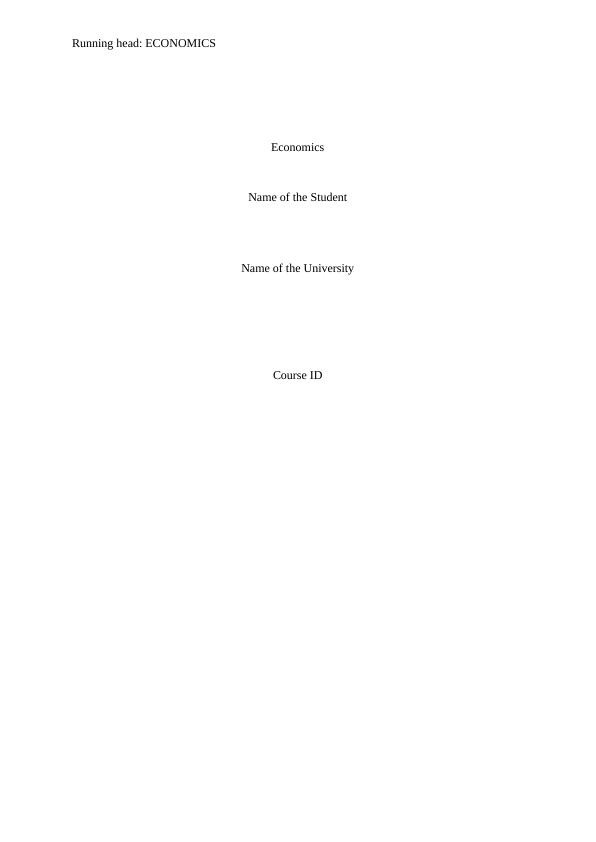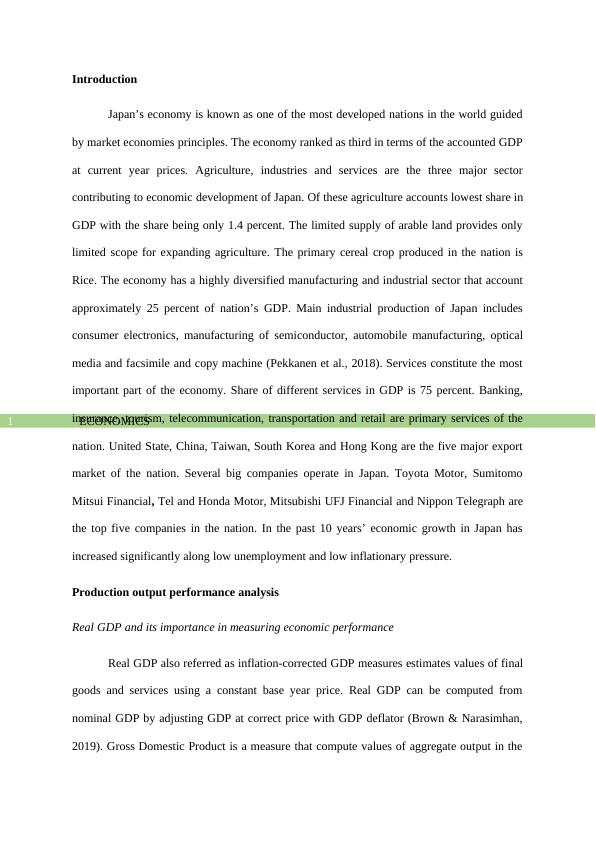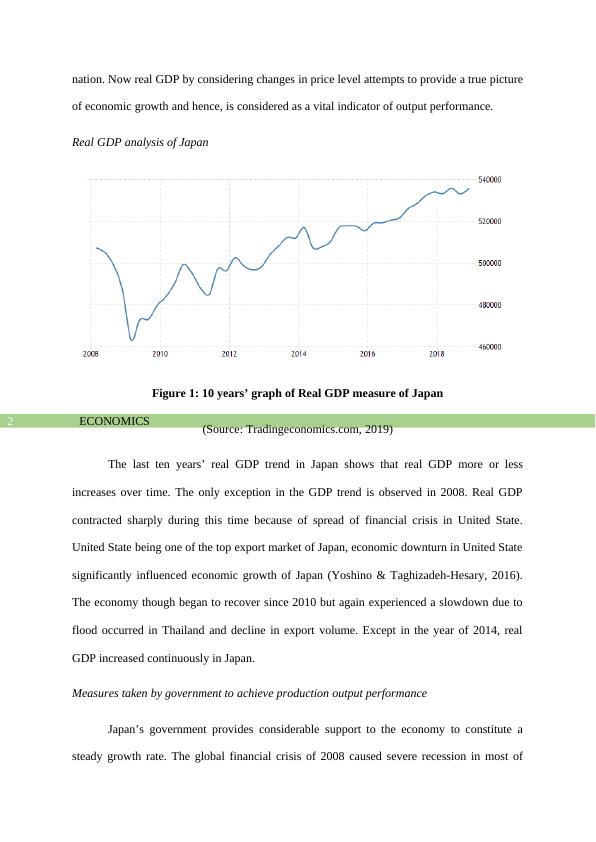Economics Assignment 2022
Added on 2022-10-11
12 Pages2818 Words21 Views
Running head: ECONOMICS
Economics
Name of the Student
Name of the University
Course ID
Economics
Name of the Student
Name of the University
Course ID

ECONOMICS1
Introduction
Japan’s economy is known as one of the most developed nations in the world guided
by market economies principles. The economy ranked as third in terms of the accounted GDP
at current year prices. Agriculture, industries and services are the three major sector
contributing to economic development of Japan. Of these agriculture accounts lowest share in
GDP with the share being only 1.4 percent. The limited supply of arable land provides only
limited scope for expanding agriculture. The primary cereal crop produced in the nation is
Rice. The economy has a highly diversified manufacturing and industrial sector that account
approximately 25 percent of nation’s GDP. Main industrial production of Japan includes
consumer electronics, manufacturing of semiconductor, automobile manufacturing, optical
media and facsimile and copy machine (Pekkanen et al., 2018). Services constitute the most
important part of the economy. Share of different services in GDP is 75 percent. Banking,
insurance, tourism, telecommunication, transportation and retail are primary services of the
nation. United State, China, Taiwan, South Korea and Hong Kong are the five major export
market of the nation. Several big companies operate in Japan. Toyota Motor, Sumitomo
Mitsui Financial, Tel and Honda Motor, Mitsubishi UFJ Financial and Nippon Telegraph are
the top five companies in the nation. In the past 10 years’ economic growth in Japan has
increased significantly along low unemployment and low inflationary pressure.
Production output performance analysis
Real GDP and its importance in measuring economic performance
Real GDP also referred as inflation-corrected GDP measures estimates values of final
goods and services using a constant base year price. Real GDP can be computed from
nominal GDP by adjusting GDP at correct price with GDP deflator (Brown & Narasimhan,
2019). Gross Domestic Product is a measure that compute values of aggregate output in the
Introduction
Japan’s economy is known as one of the most developed nations in the world guided
by market economies principles. The economy ranked as third in terms of the accounted GDP
at current year prices. Agriculture, industries and services are the three major sector
contributing to economic development of Japan. Of these agriculture accounts lowest share in
GDP with the share being only 1.4 percent. The limited supply of arable land provides only
limited scope for expanding agriculture. The primary cereal crop produced in the nation is
Rice. The economy has a highly diversified manufacturing and industrial sector that account
approximately 25 percent of nation’s GDP. Main industrial production of Japan includes
consumer electronics, manufacturing of semiconductor, automobile manufacturing, optical
media and facsimile and copy machine (Pekkanen et al., 2018). Services constitute the most
important part of the economy. Share of different services in GDP is 75 percent. Banking,
insurance, tourism, telecommunication, transportation and retail are primary services of the
nation. United State, China, Taiwan, South Korea and Hong Kong are the five major export
market of the nation. Several big companies operate in Japan. Toyota Motor, Sumitomo
Mitsui Financial, Tel and Honda Motor, Mitsubishi UFJ Financial and Nippon Telegraph are
the top five companies in the nation. In the past 10 years’ economic growth in Japan has
increased significantly along low unemployment and low inflationary pressure.
Production output performance analysis
Real GDP and its importance in measuring economic performance
Real GDP also referred as inflation-corrected GDP measures estimates values of final
goods and services using a constant base year price. Real GDP can be computed from
nominal GDP by adjusting GDP at correct price with GDP deflator (Brown & Narasimhan,
2019). Gross Domestic Product is a measure that compute values of aggregate output in the

ECONOMICS2
nation. Now real GDP by considering changes in price level attempts to provide a true picture
of economic growth and hence, is considered as a vital indicator of output performance.
Real GDP analysis of Japan
Figure 1: 10 years’ graph of Real GDP measure of Japan
(Source: Tradingeconomics.com, 2019)
The last ten years’ real GDP trend in Japan shows that real GDP more or less
increases over time. The only exception in the GDP trend is observed in 2008. Real GDP
contracted sharply during this time because of spread of financial crisis in United State.
United State being one of the top export market of Japan, economic downturn in United State
significantly influenced economic growth of Japan (Yoshino & Taghizadeh‐Hesary, 2016).
The economy though began to recover since 2010 but again experienced a slowdown due to
flood occurred in Thailand and decline in export volume. Except in the year of 2014, real
GDP increased continuously in Japan.
Measures taken by government to achieve production output performance
Japan’s government provides considerable support to the economy to constitute a
steady growth rate. The global financial crisis of 2008 caused severe recession in most of
nation. Now real GDP by considering changes in price level attempts to provide a true picture
of economic growth and hence, is considered as a vital indicator of output performance.
Real GDP analysis of Japan
Figure 1: 10 years’ graph of Real GDP measure of Japan
(Source: Tradingeconomics.com, 2019)
The last ten years’ real GDP trend in Japan shows that real GDP more or less
increases over time. The only exception in the GDP trend is observed in 2008. Real GDP
contracted sharply during this time because of spread of financial crisis in United State.
United State being one of the top export market of Japan, economic downturn in United State
significantly influenced economic growth of Japan (Yoshino & Taghizadeh‐Hesary, 2016).
The economy though began to recover since 2010 but again experienced a slowdown due to
flood occurred in Thailand and decline in export volume. Except in the year of 2014, real
GDP increased continuously in Japan.
Measures taken by government to achieve production output performance
Japan’s government provides considerable support to the economy to constitute a
steady growth rate. The global financial crisis of 2008 caused severe recession in most of

ECONOMICS3
countries in world in the contemporary period. Japan’s economy was no exception. Since the
second half of 2008, the economy entered a recession. In the beginning of 2019, the economy
contracted by more than 15.2 percent. Realizing economic slowdown, the government during
this time provided stimulatory packages to recover economic growth. The stimulatory
package valued around 7.2 trillion yen (Ihori 2015). Objective of the stimulatory package was
to rescue the household in the economy suffering because of economic stagnation lasting for
two consecutive years. Another stimulatory stimulus valued 15.4 trillion yen was announced
in the month of April of the next year. The economic plan includes spending on different
aspects. Under the package, nearly 1.6 trillion-yen investment was made for technology
leading to low carbon emission, 370 billion was invested for giving subsidies for car and 1.9
trillion yen was invested for employment generation programs.
Long term economic growth of a nation depends on the productive growth. For
securing a stable economic growth in the long run a government designs combination of
policies which include fiscal policy measure, structural reform and monetary policy with the
Bank of Japan. For improving productivity of existing labor force structural reforms are taken
to increase participation in the labor market. Along with this measures are developed to
conduct work style reform. Supporting economic growth requires support of fiscal policy
expansion. This has been done by transforming focus to the quality in prioritizing spending
(Auerbach & Gorodnichenko, 2017). A considerable amount of investment has been made to
develop infrastructure and encourage science and technological development.
Labor market analysis
Unemployment rate
The term unemployment refers to people belonging to working age population and
engage in active job search but fail to find a suitable job.
countries in world in the contemporary period. Japan’s economy was no exception. Since the
second half of 2008, the economy entered a recession. In the beginning of 2019, the economy
contracted by more than 15.2 percent. Realizing economic slowdown, the government during
this time provided stimulatory packages to recover economic growth. The stimulatory
package valued around 7.2 trillion yen (Ihori 2015). Objective of the stimulatory package was
to rescue the household in the economy suffering because of economic stagnation lasting for
two consecutive years. Another stimulatory stimulus valued 15.4 trillion yen was announced
in the month of April of the next year. The economic plan includes spending on different
aspects. Under the package, nearly 1.6 trillion-yen investment was made for technology
leading to low carbon emission, 370 billion was invested for giving subsidies for car and 1.9
trillion yen was invested for employment generation programs.
Long term economic growth of a nation depends on the productive growth. For
securing a stable economic growth in the long run a government designs combination of
policies which include fiscal policy measure, structural reform and monetary policy with the
Bank of Japan. For improving productivity of existing labor force structural reforms are taken
to increase participation in the labor market. Along with this measures are developed to
conduct work style reform. Supporting economic growth requires support of fiscal policy
expansion. This has been done by transforming focus to the quality in prioritizing spending
(Auerbach & Gorodnichenko, 2017). A considerable amount of investment has been made to
develop infrastructure and encourage science and technological development.
Labor market analysis
Unemployment rate
The term unemployment refers to people belonging to working age population and
engage in active job search but fail to find a suitable job.

End of preview
Want to access all the pages? Upload your documents or become a member.
Related Documents
Economics: Production Output Performance, Unemployment, and Price Level Analysislg...
|15
|3073
|20
Economic Performance of Japan: Real GDP, Unemployment, and Price Level Analysislg...
|13
|2771
|494
Japan's Economy: Production Output, GDP, and Labor Market Analysislg...
|10
|3438
|146
USA's Economic Performance from 2008 to 2018lg...
|13
|2830
|341
Analysis of Output Performance of Singaporelg...
|13
|2800
|34
Economics Assignment: Output Performance, Labor Market, and Price Level in Singaporelg...
|14
|2490
|173
